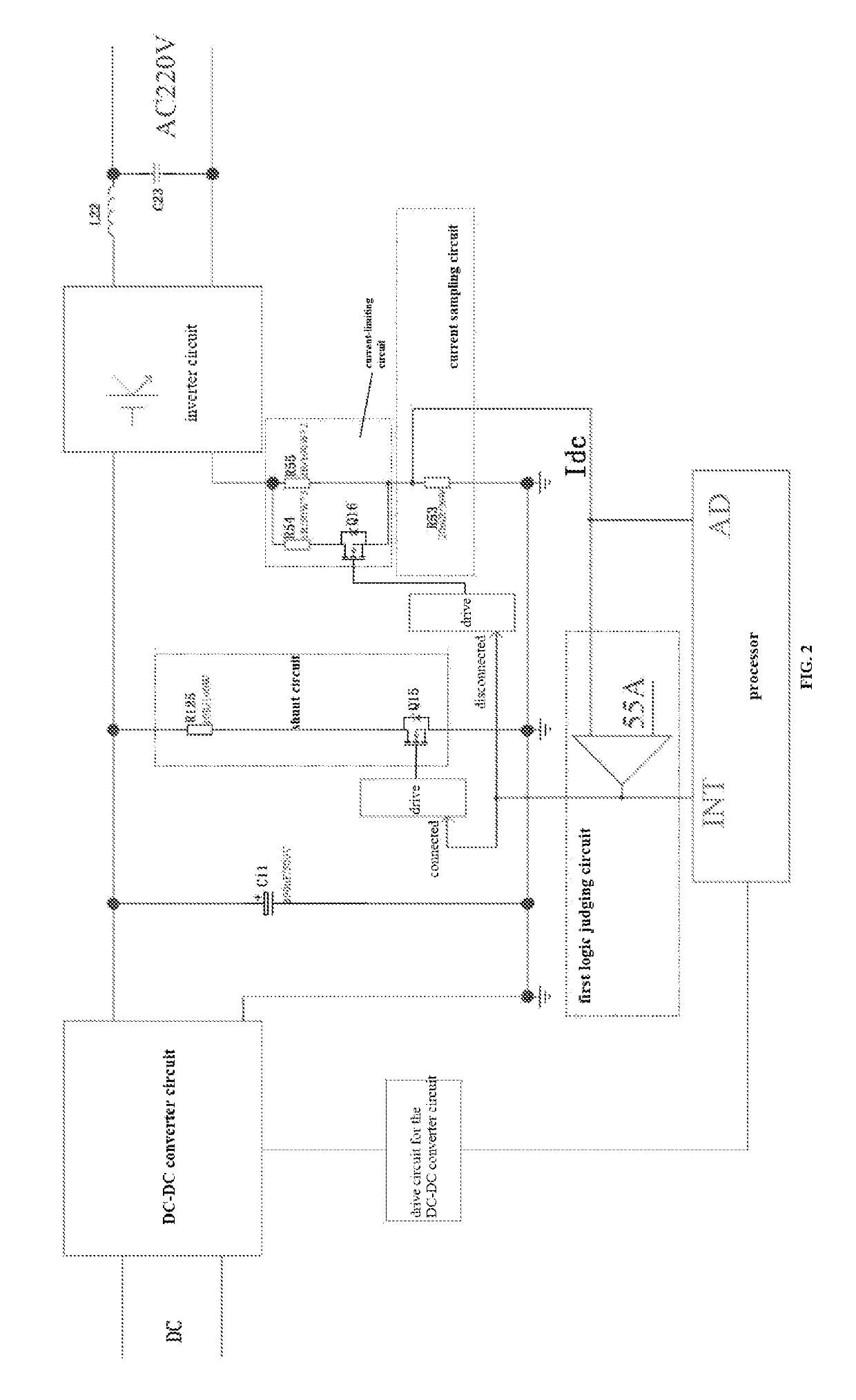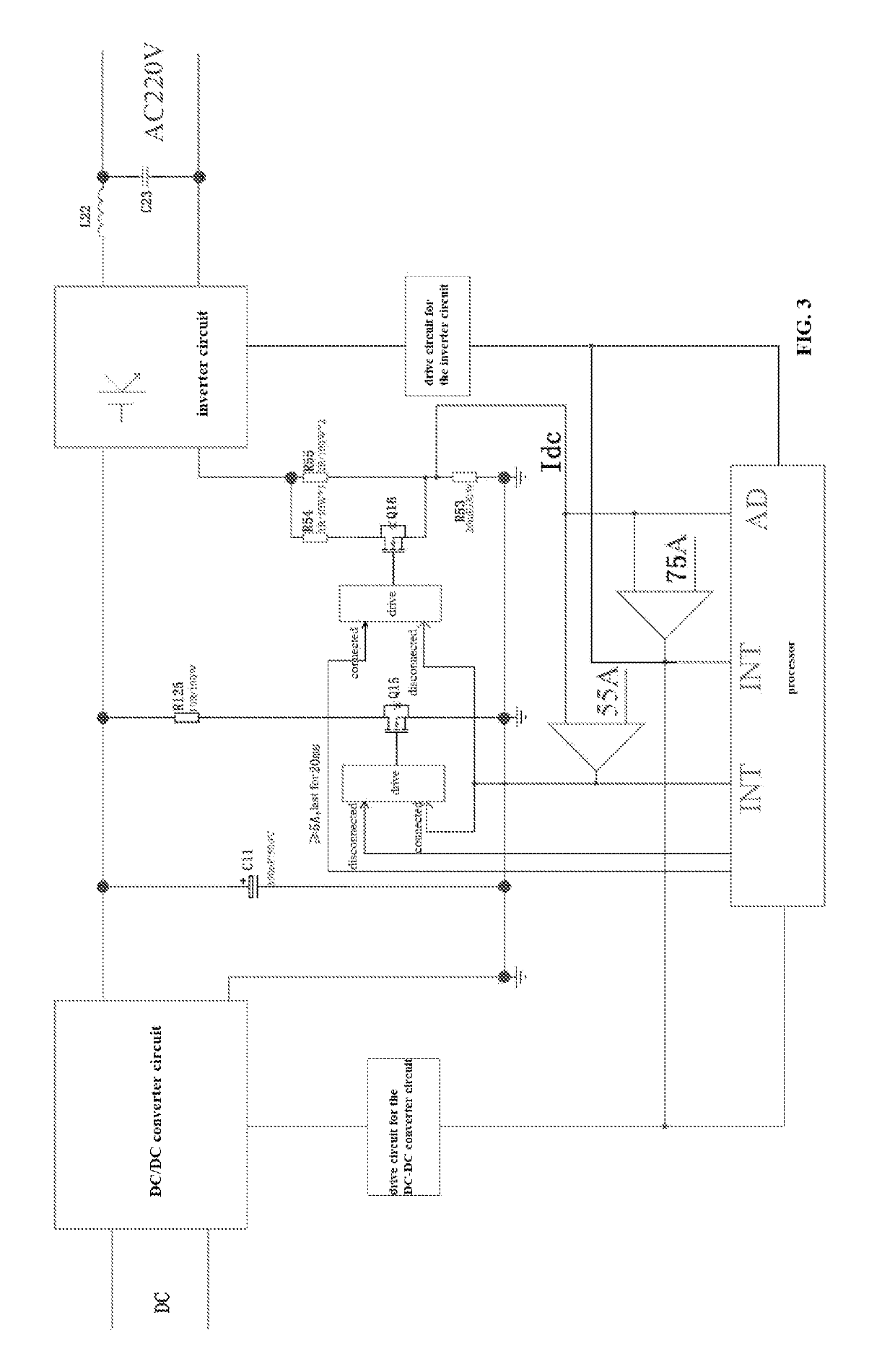Power limiting circuit for an inverter device, and inverter device
a technology of inverter circuit and power limit circuit, which is applied in the direction of power conversion system, ac-dc conversion, electrical apparatus, etc., can solve the problems of large weight of power supply devices, inconvenient movement and carrying around, and inability to meet the needs of electric power, so as to reduce the input reduce the output power of inverter circuits , the effect of small equivalent resistan
- Summary
- Abstract
- Description
- Claims
- Application Information
AI Technical Summary
Benefits of technology
Problems solved by technology
Method used
Image
Examples
embodiment 1
[0042]As shown in FIG. 2 to FIG. 5, this embodiment provides a power limiting circuit for an inverter device that comprises:
[0043]a first logic judging circuit for comparing an input current of an inverter circuit of the inverter device with a first preset current threshold and outputting a first signal when said input current is larger than the first preset current threshold; and
[0044]a shunt circuit for shunting a portion of the input current of the inverter circuit when receiving said first signal; wherein, the shunt circuit comprises a shunt resistance R125 and a first controllable switch Q15, a first end of the shunt resistance R125 is connected to a first end of the first controllable switch Q15, a second end of the shunt resistance R125 is connected to one input end of the inverter circuit, a second end of the first controllable switch Q15 is connected to the other input end of the inverter circuit, a control end of the first controllable switch Q15 is connected to an output ...
embodiment 2
[0057]As shown in FIG. 6, this embodiment provides a power limiting circuit for an inverter device, and as compared to Embodiment 1 above, its difference lies in that: it also comprises an input power limiting circuit that comprises an input current sampling circuit, an input voltage sampling circuit and an adder.
[0058]The input current sampling circuit is for sampling the input current of a DC-DC converter circuit of the inverter device and transforming the sampled current signal into corresponding voltage signal. In particular, the current on an input circuit of the DC-DC converter circuit is sampled.
[0059]The input voltage sampling circuit is for sampling the input voltage of the DC-DC converter circuit of the inverter device. In particular, the voltage is sampled by means of a first voltage-dividing resistance R22 and a second voltage-dividing resistance R29.
[0060]The adder is for adding the voltage signal outputted by the input current sampling circuit and the voltage signal ou...
embodiment 3
[0067]This embodiment provides an inverter device that comprises a DC-DC converter circuit and an inverter circuit connected in series; a drive circuit for the DC-DC converter circuit; a drive circuit for the inverter circuit; and a processor for controlling the drive circuit for the DC-DC converter circuit and the drive circuit for the inverter circuit; it also comprises a power limiting circuit for an inverter device as described in Embodiment 1 or 2 above.
[0068]Also, a capacitor C11 is connected in parallel to output ends of the DC-DC converter circuit. This capacitor C11 has wave-filtering function as well as energy-storing function. When the inverter circuit needs to be loaded with a load having a large starting current, this capacitor C11 with energy-storing function is indispensable. In practical implementation, multiple capacitors (which may be an electrolytic capacitor) connected in parallel may be arranged to carry out the wave-filtering and energy-storing functions.
[0069]...
PUM
 Login to View More
Login to View More Abstract
Description
Claims
Application Information
 Login to View More
Login to View More - R&D
- Intellectual Property
- Life Sciences
- Materials
- Tech Scout
- Unparalleled Data Quality
- Higher Quality Content
- 60% Fewer Hallucinations
Browse by: Latest US Patents, China's latest patents, Technical Efficacy Thesaurus, Application Domain, Technology Topic, Popular Technical Reports.
© 2025 PatSnap. All rights reserved.Legal|Privacy policy|Modern Slavery Act Transparency Statement|Sitemap|About US| Contact US: help@patsnap.com



